Kuhli loach - Pangio kuhlii
Scientific name: Pangio kuhlii
Common name: Kuhli loach
Family: Cobitidae
Usual size in fish tanks: 7 - 10 cm (2.76 - 3.94 inch)
014
Recommended pH range: 6.5 - 7
Recommended water hardness: 8 - 12°N (142.86 - 214.29ppm)
0°C 32°F30°C 86°F
Recommended temperature range: 24 - 30 °C (75.2 - 86°F)
The way how these fish reproduce: Spawning
Where the species comes from: South Asia
Temperament to its own species: peaceful
Temperament toward other fish species: peaceful
Usual place in the tank: Bottom levels
Overview
The Kuhli Loach (Pangio kuhlii), also known as the Coolie Loach, is a fascinating species native to Southeast Asia, particularly Java and Borneo. This unique and intriguing fish is known for its eel-like appearance and peaceful nature, making it a popular choice for community aquariums worldwide. Kuhli Loaches are shy and often prefer to stay hidden during the day, becoming more active during the evening and nighttime hours. When provided with the right environment and care, they can thrive and add a touch of charm to any aquarium.
Appearance
The Kuhli Loach has a distinctive, slender body that closely resembles an eel. Adults can grow to a length of 7-10 cm (2.76 - 3.94 inches). Their bodies are typically light yellow with dark brown or black bands running across their backs and sides, giving them a striking striped appearance. Some variants are almost completely black with a few yellow stripes, while an albino form with a white body and pinkish markings is occasionally seen in the aquarium trade. These unique colorations make the Kuhli Loach an easily recognizable and attractive addition to freshwater tanks.
Behavior and Tank Setup
Kuhli Loaches are known for their peaceful and shy demeanor. They spend much of their time hiding among plants, rocks, and decorations due to their timid nature. Therefore, it is essential to provide plenty of hiding spots in the aquarium, such as caves, driftwood, and dense vegetation. Using a sandy substrate is crucial, as these loaches like to burrow and sift through the sand in search of food. Coarse or sharp substrates can harm their delicate bodies and barbels.
Kuhli Loaches are social creatures and should be kept in groups of at least five or six to feel secure and exhibit natural behaviors. A minimum tank size of 80 liters (20 gallons) is recommended to provide ample space for them to swim and explore. They thrive best in a mature, well-established aquarium with stable water parameters. These fish are highly sensitive to water quality, so maintaining good filtration and performing regular water changes are vital for their health.
Water Conditions
Kuhli Loaches prefer slightly acidic to neutral water with a pH range of 6.5 - 7.0 and soft to moderately hard water with a hardness of 8-12°N (142.86 - 214.29 ppm). They thrive in warmer water temperatures, ideally between 24 - 30°C (75.2 - 86°F). Consistent water conditions are essential, as these loaches are sensitive to sudden changes in temperature and water chemistry.
Diet and Feeding
In the wild, Kuhli Loaches are scavengers, feeding on small invertebrates and organic matter. In the aquarium, they will happily consume leftover food that sinks to the bottom, making them excellent clean-up crew members. However, to ensure they receive proper nutrition, it is important to supplement their diet with quality foods designed for bottom-dwelling fish. Offer a mix of sinking pellets, granules, and occasional live or frozen foods such as bloodworms, brine shrimp, and daphnia. These nocturnal feeders are most active during the evening, so feeding them just before lights out can encourage their natural foraging behavior.
Compatibility and Tankmates
Kuhli Loaches are peaceful and do well in community tanks with other non-aggressive species. They are compatible with a wide range of tankmates, including small tetras, rasboras, guppies, and other bottom-dwellers like Corydoras. Avoid keeping them with larger, aggressive fish that may see them as prey or compete with them for food. Due to their shy nature, they are best suited to aquariums with subdued lighting and plenty of hiding spots to help them feel secure.
Breeding
Breeding Kuhli Loaches in captivity is challenging and rarely occurs in the home aquarium. They are egg scatterers and require specific conditions to trigger spawning. In nature, breeding typically occurs during the rainy season when water levels and temperatures change. To encourage breeding in an aquarium, provide dense plant cover and slightly increase the water temperature. However, even under ideal conditions, breeding success is not guaranteed. If spawning occurs, the female will scatter her eggs among the plants, and the eggs will hatch in about 24 hours. The fry are tiny and should be fed infusoria or other small foods until they grow large enough to accept finely crushed flakes or micro-worms.
Lifespan
With proper care, Kuhli Loaches can live up to 10 years in a well-maintained aquarium. Their relatively long lifespan makes them a rewarding choice for aquarists seeking a unique and long-term addition to their tank. Providing a stable environment, a varied diet, and plenty of hiding places will help ensure they remain healthy and active throughout their lives.
Conclusion
Kuhli Loaches are fascinating, eel-like fish that bring a special charm to community aquariums. Their peaceful nature, combined with their unique appearance and behavior, makes them a favorite among both novice and experienced aquarists. By offering the right tank setup, diet, and water conditions, you can enjoy the company of these shy yet captivating bottom-dwellers for many years to come.
Questions and Answers
- Can Kuhli Loaches live alone?
While they can survive alone, Kuhli Loaches are social fish that thrive in groups. Keeping at least five or six together will help them feel secure and display more natural behaviors.
- Do Kuhli Loaches need a heater?
Yes, Kuhli Loaches prefer warm water, with an ideal temperature range of 24 - 30°C (75.2 - 86°F). A heater is necessary to maintain a stable temperature in their tank, especially in cooler climates.
- How often should I feed Kuhli Loaches?
Feed Kuhli Loaches once or twice daily, offering a small amount of food that they can consume within a few minutes. They are nocturnal feeders, so it's best to feed them in the evening when they are more active.
- Do Kuhli Loaches need hiding places?
Yes, Kuhli Loaches are shy and require plenty of hiding spots to feel secure. Providing caves, plants, and driftwood will create a safe environment where they can retreat during the day.
Suggested Plants
Kuhli Loaches appreciate a well-planted tank with plenty of cover. Suitable plants include Anubias, Java Fern, Cryptocoryne Wendtii, and Amazon Sword. These plants can thrive in the low to moderate light conditions that Kuhli Loaches prefer and provide them with shaded areas to hide. Floating plants like Pistia can also help diffuse the lighting, creating a more comfortable environment for these nocturnal fish.
Pictures
Thanks to L. Staunton!
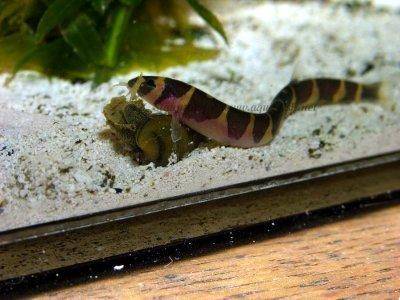






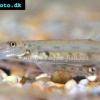 Horseface
Horseface  Horseface
Horseface  YoYo
YoYo 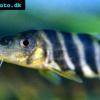 Bengal
Bengal  Burmese
Burmese 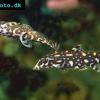 Myanmar
Myanmar  Zebra
Zebra  Clown
Clown  Dojo
Dojo  Loach
Loach  Tiger
Tiger 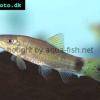 Tailspot
Tailspot  Blue
Blue